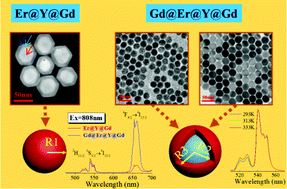Effects of Er3+ spatial distribution on luminescence properties and temperature sensing of upconverting core–shell nanocrystals with high Er3+ content†
Abstract
In upconversion nanocrystals where Er3+ acts as the activator, concentration quenching will easily occur when the content of Er3+ is high (generally >5mol%), and the Er3+ spatial distribution which is a key factor affecting the concentration quenching is an important issue that must be considered. Herein, we selected Yb:NaErF4 as a light-emitting layer and investigated its upconversion performance and temperature sensing behaviors in two kinds of core–shell nanoarchitectures. Yb3+ and Er3+ activators were distributed in a three-dimensional sphere and two-dimensional thin layer in Yb:NaErF4@Yb/Nd:NaYF4@NaGdF4 and NaGdF4@Yb:NaErF4@Yb/Nd:NaYF4@NaGdF4 core–shell nanocrystals, respectively. The difference in Er3+ spatial distribution in the core–shell structure resulted in significant modification of red-to-green ratios and decay behaviors upon excitation at 376 nm, 808 nm, 980 nm and 1532 nm, and the related mechanisms were systematically investigated. In addition, the spatial distribution of Er3+ was demonstrated to have no obvious effect on the transitions of Er3+ thermally coupled 2H11/2 → 4I15/2 and 4S3/2 → 4I15/2 and the relative sensitivity for temperature determination under 808 nm laser excitation.



 Please wait while we load your content...
Please wait while we load your content...